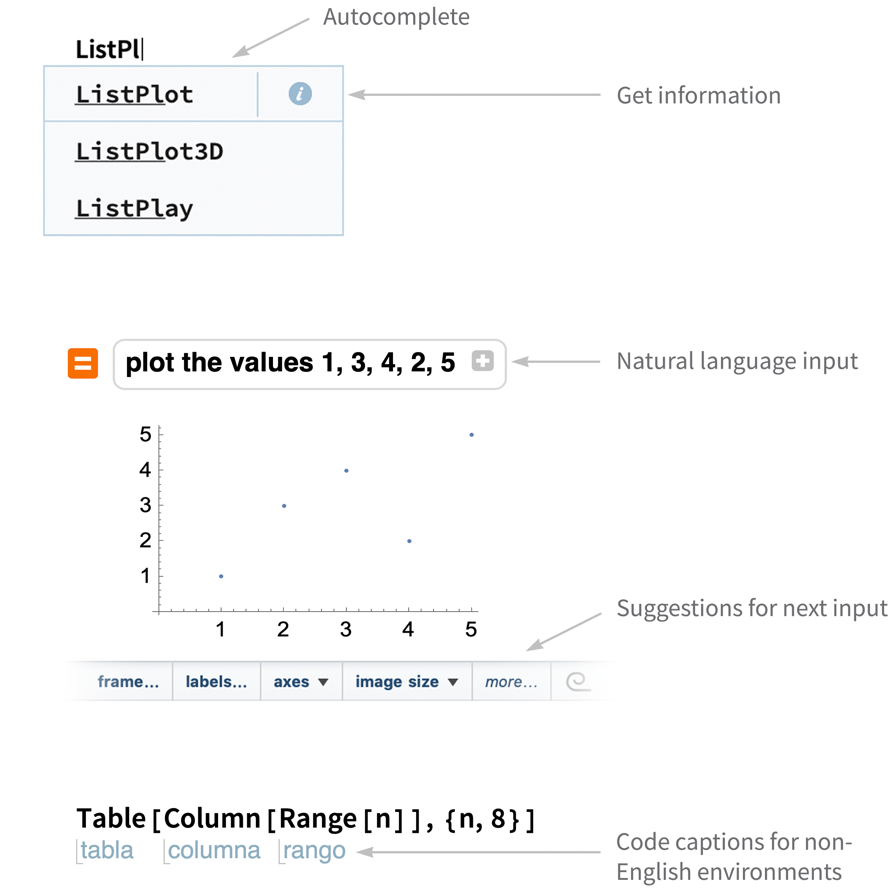The best way to learn the Wolfram Language is to use it. You can do that in any Wolfram System environment—on your desktop, on the web or on a mobile device.
In such an environment, you enter Wolfram Language input, and the system immediately computes output from it. On desktop and web, you typically type  to say you’ve finished your input; on mobile you typically press the
to say you’ve finished your input; on mobile you typically press the  button.
button.
Your sequence of inputs and outputs—together with any text you may add—all exists in a Wolfram Notebook.

You can publish Wolfram Notebooks to the Wolfram Cloud, so anyone can access them with a web browser.
Within a Wolfram Notebook you’ll see various aids to help you enter input.

Wolfram Notebooks, with their interactive sequences of inputs and outputs, are an ideal way to learn, explore and write programs in the Wolfram Language. But the Wolfram Language can also operate without its interactive interface, in a whole variety of software-engineering configurations. Inside, though, the language still works exactly the same as what we discuss in this book.
Do I need to know programming to read this book?
Absolutely not. This book provides a self-contained introduction to programming.
What age group is this book suitable for?
Experience suggests that anything above about age 11 is appropriate. I’ve tried to choose examples that will be relevant and engaging to all age groups, very much including adults.
How much math do I need to know to read this book?
Nothing beyond basic arithmetic. This is a book about computation, not about math.
Can I study this book in a course?
Yes, there’s an online course at wolfr.am/u-eiwl, with videos, automatically graded exercises, and more. The book is also routinely used as a basis for study groups and a variety of educational programs.
Do I need to use a computer while reading this book?
You could read it without one, but it will be much better to try things out interactively with a Wolfram Language session. If nothing else, you can do this as part of the online course based on this book.
Where can I run the Wolfram Language?
It runs natively on desktop computers: Mac, Windows, Linux (including Raspberry Pi). It also runs in the cloud through a web browser, and on mobile devices.
Do I have to read this book sequentially?
It will be a lot better that way. I’ve constructed the book so it progressively builds up a broader and broader base of concepts. If you jump around, you’ll probably need to backtrack a lot.
Why are the topics in this book so different from typical programming books?
Because the Wolfram Language is a different and higher-level kind of language, that automates away many of the details that typical programming books concentrate on.
Is the Wolfram Language an educational language?
It’s certainly used for education (and Mathematica is ubiquitous at universities). But it’s also very widely used in industry. It’s good for education because it’s powerful and easy to learn.
Will learning the Wolfram Language help in learning other languages?
Definitely. Knowing the Wolfram Language you’ll understand higher-level concepts, which you’ll then see played out in lower-level ways in other languages.
The Wolfram Language seems too easy; is it really programming?
Definitely. And because it automates away the drudgery you might associate with programming, you’ll be able to go much further, and understand much more.
What version of the Wolfram Language does this book assume I will use?
Anything 13.1 and above. Note that examples won’t work if your version is from before the functionality they use was introduced. If you’re running the Wolfram Language in the Wolfram Cloud you’ll always be using the latest version, but if you’re running on a desktop system you may explicitly have to upgrade.
Is the code in the book “production grade”?